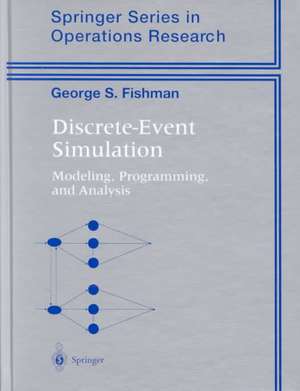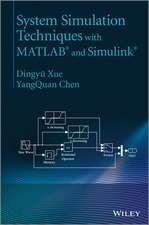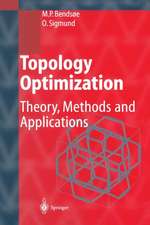Discrete-Event Simulation: Modeling, Programming, and Analysis: Springer Series in Operations Research and Financial Engineering
Autor George S. Fishmanen Limba Engleză Hardback – 27 iun 2001
This book is intended for upper level undergraduate and graduate students in operations research and management science, mathematics, industrial engineering, computer science, and business and features extensive exercises throughout. This concept of modelling complex sytems allows a relatively low-cost way of gathering information for decision-making.
Principally offered are four problems for student exercises; each is progressively brought forward through the modelling, programming, and analysis chapters, providing continuity to the learning process.
| Toate formatele și edițiile | Preț | Express |
|---|---|---|
| Paperback (1) | 665.09 lei 6-8 săpt. | |
| Springer – 21 sep 2011 | 665.09 lei 6-8 săpt. | |
| Hardback (1) | 639.28 lei 38-45 zile | |
| Springer – 27 iun 2001 | 639.28 lei 38-45 zile |
Din seria Springer Series in Operations Research and Financial Engineering
- 13%
 Preț: 355.75 lei
Preț: 355.75 lei - 17%
 Preț: 370.05 lei
Preț: 370.05 lei - 15%
 Preț: 365.76 lei
Preț: 365.76 lei - 17%
 Preț: 363.08 lei
Preț: 363.08 lei -
 Preț: 347.47 lei
Preț: 347.47 lei -
 Preț: 497.00 lei
Preț: 497.00 lei -
 Preț: 356.91 lei
Preț: 356.91 lei - 19%
 Preț: 575.59 lei
Preț: 575.59 lei - 15%
 Preț: 638.43 lei
Preț: 638.43 lei - 18%
 Preț: 740.57 lei
Preț: 740.57 lei - 18%
 Preț: 945.30 lei
Preț: 945.30 lei -
 Preț: 384.48 lei
Preț: 384.48 lei - 23%
 Preț: 732.07 lei
Preț: 732.07 lei -
 Preț: 407.98 lei
Preț: 407.98 lei - 18%
 Preț: 1395.63 lei
Preț: 1395.63 lei -
 Preț: 358.39 lei
Preț: 358.39 lei - 20%
 Preț: 549.58 lei
Preț: 549.58 lei - 18%
 Preț: 737.43 lei
Preț: 737.43 lei - 15%
 Preț: 660.37 lei
Preț: 660.37 lei -
 Preț: 411.67 lei
Preț: 411.67 lei -
 Preț: 391.02 lei
Preț: 391.02 lei - 18%
 Preț: 898.13 lei
Preț: 898.13 lei -
 Preț: 405.06 lei
Preț: 405.06 lei - 15%
 Preț: 637.28 lei
Preț: 637.28 lei -
 Preț: 495.84 lei
Preț: 495.84 lei - 19%
 Preț: 526.97 lei
Preț: 526.97 lei -
 Preț: 391.02 lei
Preț: 391.02 lei -
 Preț: 392.97 lei
Preț: 392.97 lei - 15%
 Preț: 538.61 lei
Preț: 538.61 lei - 15%
 Preț: 880.15 lei
Preț: 880.15 lei - 24%
 Preț: 831.85 lei
Preț: 831.85 lei - 18%
 Preț: 837.15 lei
Preț: 837.15 lei - 18%
 Preț: 801.65 lei
Preț: 801.65 lei - 19%
 Preț: 529.48 lei
Preț: 529.48 lei -
 Preț: 391.42 lei
Preț: 391.42 lei - 15%
 Preț: 592.77 lei
Preț: 592.77 lei
Preț: 639.28 lei
Preț vechi: 799.10 lei
-20% Nou
Puncte Express: 959
Preț estimativ în valută:
122.33€ • 130.81$ • 101.99£
122.33€ • 130.81$ • 101.99£
Carte tipărită la comandă
Livrare economică 14-21 aprilie
Preluare comenzi: 021 569.72.76
Specificații
ISBN-13: 9780387951607
ISBN-10: 0387951601
Pagini: 560
Ilustrații: XIX, 537 p. 50 illus.
Dimensiuni: 178 x 235 x 35 mm
Greutate: 1.08 kg
Ediția:2001
Editura: Springer
Colecția Springer
Seria Springer Series in Operations Research and Financial Engineering
Locul publicării:New York, NY, United States
ISBN-10: 0387951601
Pagini: 560
Ilustrații: XIX, 537 p. 50 illus.
Dimensiuni: 178 x 235 x 35 mm
Greutate: 1.08 kg
Ediția:2001
Editura: Springer
Colecția Springer
Seria Springer Series in Operations Research and Financial Engineering
Locul publicării:New York, NY, United States
Public țintă
GraduateCuprins
1 Simulation in Perspective.- 2 Modeling Concepts.- 3 Data Collection and Averages.- 4 Programming and Execution.- 5 Search, Space, and Time.- 6 Output Analysis.- 7 Making Sense of Output and Increasing Efficiency.- 8 Sampling from Probability Distributions.- 9 Pseudorandom Number Generation.- 10 Preparing the Input.- Appendix More on the Batch-Means Method.- A.1 FNB Rule (Section 6.6.4).- A.2 SQRT Rule (Section 6 6 5).- Author Index.
Recenzii
From the reviews:
"This is an excellent and well-written text on discrete event simulation with a focus on applications in Operations Research. There is substantial attention to programming, output analysis, pseudo-random number generation and modelling and these sections are quite thorough. Methods are provided for generating pseudo-random numbers (including combining such streams) and for generating random numbers from most standard statistical distributions."
ISI Short Book Reviews, Vol. 22/2, August 2002
"This 537-page book is primarily a text to support the teaching of discrete-event simulation for post-graduates and final-year undergraduates. ... The book is a reasonably full, theory based, introduction to the technique of discrete-event simulation. Fishman’s earlier texts (1973 and 1978) established themselves as common points of reference and this book is likely to join them. It is worth considering as a course text or as a reference work for simulation users, and certainly as a worthwhile addition to relevant libraries." (B. Hollocks, Journal of the Operational Research Society, Vol. 54, 2003)
"This book is a comprehensive text and reference for simulation of continuous-time processes that change state only at discrete, typically random, times. ... The coverage is substantial ... . there is considerable detail on simulating particular kinds of interevent distributions and reasonable attention to interpretation and statistical analysis of simulation output ... . The SIM-SCRIPT programming language is used to illustrate specific techniques." (Alan F. Karr, Journal of the American Statistical Association, December, 2002)
"Besides the good choice of material of the book and its clear and excellent methodological presentation the referee has ... to stress on two points that distinguish Fishman’s book positive from others. One is that each chapter finishes with three subchapters – lessons learned,(interesting) exercises, and (actual and voluminous) references. The second one is that the book contains a multitude of accessible through the internet software sources. ... Fishman’s book can be highly recommended for practitioners as well as for students and simulation specialists." (P. Köchel, Operations Research-Spektrum, Issue 17, 2003)
"This is an excellent and well-written text on discrete event simulation with a focus on applications in Operations Research. There is substantial attention to programming (largely in SIMSCRIPT II.5), output analysis, pseudo-random number generation and modelling and these sections are quite thorough. ... a text that is accessible, coherent and readable on those topics of major interest to ‘simulationists’ in the management and engineering sciences." (D. L. McLeish, Short Book Reviews, August, 2002)
"This book covers the whole life cycle of the discrete-event simulation process ... . the author gives an excellent and complete introduction to all aspects related to discrete-event computer simulation. ... this book is highly recommendable either to be used as a text for a course on discrete-event simulation or as a reference for discrete-event simulation, as it provides a balance between theoretical and practical issues, including coding in different simulation languages and plentiful examples which are well developed throughout the book." (Juan de Lara Jaramillo, Journal of Artificial Societies and Social Simulation Vol. 5 (3), September, 2002)
"Since students often learn about discrete-event simulation through particular software’s modelling, sampling, analysis and reporting capabilities, their skills for overcoming impediments may be severely limited unless they are well versed in the basic concepts of discrete-event simulation. ... This book supplies a mean for providing the needed background. It gives relatively detailed account of the principal methodologies of discrete-event simulation.... At the end of nearly all chapters are exercises, which are well described." (Barbara Pototschnig, Simulation News Europe, Issue 34, 2002)
"Once a simulation procedure is adopted, one must apply the simulation techniques interactively with the adaptation of the modelling techniques ... . In this context the book is a valuable basis for acquiring the necessary skills ... . The book is highly recommended as an introductory course for graduate and advanced undergraduate students in the mathematical and engineering sciences, particularly operations research, industrial engineering, operations management ... and to the professionals in these fields who are interested to broaden their knowledge of discrete-event simulation." (Mihail Voicu, Zentralblatt MATH, Vol. 973, 2001)
"This is an excellent and well-written text on discrete event simulation with a focus on applications in Operations Research. There is substantial attention to programming, output analysis, pseudo-random number generation and modelling and these sections are quite thorough. Methods are provided for generating pseudo-random numbers (including combining such streams) and for generating random numbers from most standard statistical distributions."
ISI Short Book Reviews, Vol. 22/2, August 2002
"This 537-page book is primarily a text to support the teaching of discrete-event simulation for post-graduates and final-year undergraduates. ... The book is a reasonably full, theory based, introduction to the technique of discrete-event simulation. Fishman’s earlier texts (1973 and 1978) established themselves as common points of reference and this book is likely to join them. It is worth considering as a course text or as a reference work for simulation users, and certainly as a worthwhile addition to relevant libraries." (B. Hollocks, Journal of the Operational Research Society, Vol. 54, 2003)
"This book is a comprehensive text and reference for simulation of continuous-time processes that change state only at discrete, typically random, times. ... The coverage is substantial ... . there is considerable detail on simulating particular kinds of interevent distributions and reasonable attention to interpretation and statistical analysis of simulation output ... . The SIM-SCRIPT programming language is used to illustrate specific techniques." (Alan F. Karr, Journal of the American Statistical Association, December, 2002)
"Besides the good choice of material of the book and its clear and excellent methodological presentation the referee has ... to stress on two points that distinguish Fishman’s book positive from others. One is that each chapter finishes with three subchapters – lessons learned,(interesting) exercises, and (actual and voluminous) references. The second one is that the book contains a multitude of accessible through the internet software sources. ... Fishman’s book can be highly recommended for practitioners as well as for students and simulation specialists." (P. Köchel, Operations Research-Spektrum, Issue 17, 2003)
"This is an excellent and well-written text on discrete event simulation with a focus on applications in Operations Research. There is substantial attention to programming (largely in SIMSCRIPT II.5), output analysis, pseudo-random number generation and modelling and these sections are quite thorough. ... a text that is accessible, coherent and readable on those topics of major interest to ‘simulationists’ in the management and engineering sciences." (D. L. McLeish, Short Book Reviews, August, 2002)
"This book covers the whole life cycle of the discrete-event simulation process ... . the author gives an excellent and complete introduction to all aspects related to discrete-event computer simulation. ... this book is highly recommendable either to be used as a text for a course on discrete-event simulation or as a reference for discrete-event simulation, as it provides a balance between theoretical and practical issues, including coding in different simulation languages and plentiful examples which are well developed throughout the book." (Juan de Lara Jaramillo, Journal of Artificial Societies and Social Simulation Vol. 5 (3), September, 2002)
"Since students often learn about discrete-event simulation through particular software’s modelling, sampling, analysis and reporting capabilities, their skills for overcoming impediments may be severely limited unless they are well versed in the basic concepts of discrete-event simulation. ... This book supplies a mean for providing the needed background. It gives relatively detailed account of the principal methodologies of discrete-event simulation.... At the end of nearly all chapters are exercises, which are well described." (Barbara Pototschnig, Simulation News Europe, Issue 34, 2002)
"Once a simulation procedure is adopted, one must apply the simulation techniques interactively with the adaptation of the modelling techniques ... . In this context the book is a valuable basis for acquiring the necessary skills ... . The book is highly recommended as an introductory course for graduate and advanced undergraduate students in the mathematical and engineering sciences, particularly operations research, industrial engineering, operations management ... and to the professionals in these fields who are interested to broaden their knowledge of discrete-event simulation." (Mihail Voicu, Zentralblatt MATH, Vol. 973, 2001)
Caracteristici
Leading authority in the area provides basic treatment of the subject Written from the perspective of today's highly interactive PC and workstation environments Each example is brought forward through the modeling, programming and analysis chapters, providing continuity to the learning process Request lecturer material: sn.pub/lecturer-material














